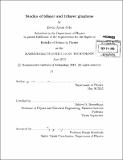| dc.contributor.advisor | Mildred S. Dresselhaus. | en_US |
| dc.contributor.author | Cela, Devin Artan | en_US |
| dc.contributor.other | Massachusetts Institute of Technology. Department of Physics. | en_US |
| dc.date.accessioned | 2014-01-09T19:57:56Z | |
| dc.date.available | 2014-01-09T19:57:56Z | |
| dc.date.issued | 2013 | en_US |
| dc.identifier.uri | http://hdl.handle.net/1721.1/83814 | |
| dc.description | Thesis (S.B.)--Massachusetts Institute of Technology, Dept. of Physics, 2013. | en_US |
| dc.description | Cataloged from PDF version of thesis. | en_US |
| dc.description | Includes bibliographical references (pages 69-76). | en_US |
| dc.description.abstract | Graphene is a single 2-dimensional atomic layer of hexagonally packed carbon atoms. Graphene has a unique combination of thermal, mechanical, and electronic properties, making it a useful tool for learning new physics as well as a material with high potential for applications. Bilayer graphene (2LG) and trilayer graphene (3LG) share many of the interesting properties of its monolayer relative, but with several key differences. This thesis makes use of resonant Raman spectroscopy to characterize these systems and quantify their layer number as well as stacking order in different graphene flakes. Three distinct graphitic systems were studied: bilayer graphene with Bernal stacking, and trilayer graphene with both Bernal and rhombohedral stacking. A number of back-gated bilayer and trilayer graphene devices were created via the method of mechanical exfoliation. The type of stacking and number of layers was confirmed using resonant Raman spectroscopy. Electron beam lithography was used in combination with a positive PMMA resist in order to pattern samples. Metal was then evaporated onto samples to create electrical contacts for use in gated measurements. These samples, along with my procedure, will be used for future measurement by members of the Dresselhaus research group. These gated graphene devices will be used with gate-modulated resonant Raman spectroscopy (GMMRS) in order to explore the electron-phonon properties of AB 2LG, ABA 3LG, and ABC 3LG graphene. | en_US |
| dc.description.statementofresponsibility | by Devin Artan Cela. | en_US |
| dc.format.extent | 76 pages | en_US |
| dc.language.iso | eng | en_US |
| dc.publisher | Massachusetts Institute of Technology | en_US |
| dc.rights | M.I.T. theses are protected by
copyright. They may be viewed from this source for any purpose, but
reproduction or distribution in any format is prohibited without written
permission. See provided URL for inquiries about permission. | en_US |
| dc.rights.uri | http://dspace.mit.edu/handle/1721.1/7582 | en_US |
| dc.subject | Physics. | en_US |
| dc.title | Studies of bilayer and trilayer graphene | en_US |
| dc.title.alternative | Studies of 2LG and 3LG | en_US |
| dc.type | Thesis | en_US |
| dc.description.degree | S.B. | en_US |
| dc.contributor.department | Massachusetts Institute of Technology. Department of Physics | |
| dc.identifier.oclc | 865478299 | en_US |
